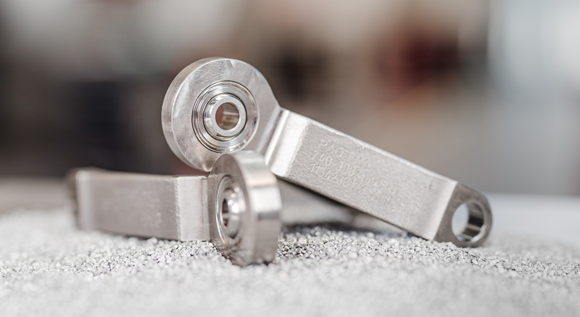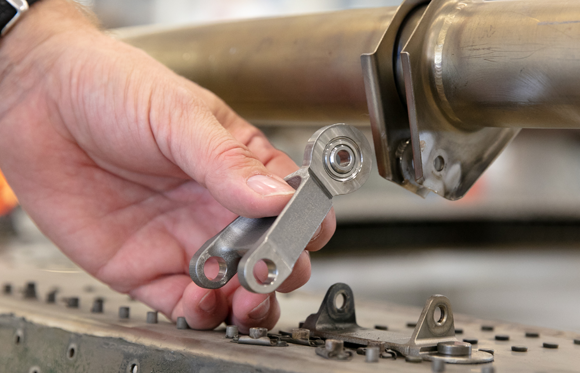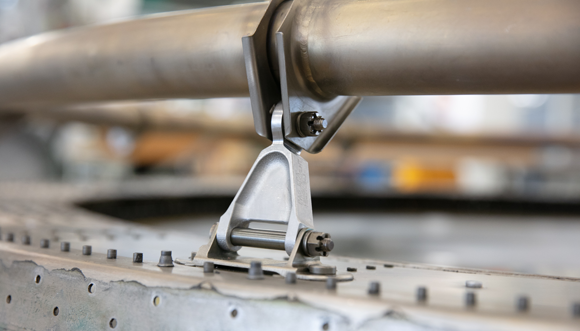Lufthansa Technik and Premium Aerotec’s AM flight part receives EASA certification
June 9, 2022

Lufthansa Technik AG Hamburg, Germany, and Premium Aerotec, headquartered in Augsburg, Germany, report that a metal additively manufactured component developed at Lufthansa Technik’s Additive Manufacturing (AM) Center for the IAE-V2500 engine’s anti-icing system, has received official aviation certification from EASA (European Union Aviation Safety Agency).
The companies have been collaborating in an effort to use Additive Manufacturing methods for a more cost-efficient aircraft spare parts production. With the EASA certification, Premium Aerotec will additively manufacture the A-link component for Lufthansa Technik at its Varel site.
A total of nine A-links fix a ring-shaped hot air duct in the engine’s inlet cowl, thus protected from ice buildup during flight operations. However, the vibrations that occur here during operation cause the A-links to wear at their mounting holes, so that after a few years replacements are needed.
As the A-links can be exposed to temperatures of up to 300°C, they are made of titanium. The original component was manufactured by a forging process to meet the highest requirements for material properties. The new manufacturing solution developed by Premium Aerotec and Lufthansa Technik is additively manufactured using the Laser Beam Powder Bed Fusion (PBF-LB) process. This process can save valuable material since removal after the build is only necessary to a small extent on some functional surfaces.

However, the properties of the components produced in this way, for example, their strength, are heavily dependent on the corresponding Additive Manufacturing process, the qualification of which must therefore be proven in a complex procedure. Premium Aerotec carried out a large number of “print jobs” with test specimens, with constant settings of all process-relevant parameters. This way, it was finally possible to establish a constant and reliable process and to prove that the highest requirements in terms of material properties are also achieved here. In terms of tensile strength, the additively manufactured A-Link is reported to be superior to the original part.
As part of this certification process, Lufthansa Technik has now extended the expertise of its EASA Part 21/J development facility to include additively manufactured metal components. For Premium Aerotec, the cooperation with Lufthansa Technik is a significant milestone in the field of Additive Manufacturing, as it is the first time the company has supplied a customer outside the Airbus Group with AM series components. The first A-Links from the cooperation will be used in the Lufthansa fleet, where long-term experience with the new components is to be gained beyond certification.
“Premium Aerotec is an international pioneer and technology leader in the Additive Manufacturing of aerospace components. Our company has already been applying this technology in the series production of complex structural components since 2016,” stated Dr Ulrich Weber, Chief Operating Officer at Premium Aerotec. “I am very pleased that in cooperation with Lufthansa Technik we can now once again demonstrate our comprehensive expertise in 3D printing.”

Soeren Stark, Chief Operating Officer of Lufthansa Technik, stated, “We have been producing components for the aircraft cabin, the vast majority of which are made of plastic, using 3D printing for years. Now we are able to demonstrate that structurally relevant metal parts for use outside the cabin can also be manufactured additively and approved for flight operations. In this way, we have not only achieved a cost saving for the component in question, but also defined and qualified all the necessary processes for the application of this groundbreaking manufacturing method for structurally relevant metal parts.”
The first aviation certification of a load-bearing metal spare part currently is intended to only represent a first step for both partners, as its geometry still largely corresponds to the original part explains Lufthansa Technik. Future developments in the technology will also make it possible to use the advantages of Additive Manufacturing for targeted optimisation of the geometry. Theoretically, there are no limits to the shaping of additively manufactured components, so that they can then be produced much more easily and with less material while retaining the same strength and function.
















